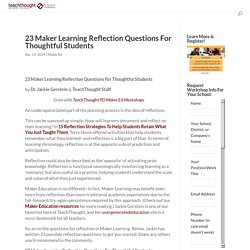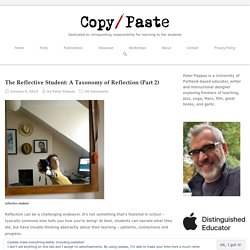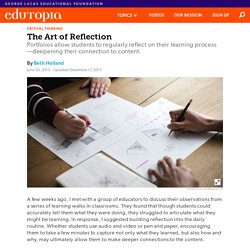

IQ2US Debates. BBC Radio 4 - The Educators, Sir Ken Robinson. Reflection tools and idea's. What does if mean to be Reflexive and Reflective Professional? Reflective and Reflexive Practice. Reflexivity in Perception. Bill Gates: Teachers need real feedback. Feedback for Learning. How Giving Students Feedback Through Video Instead of Text Can Foster Better Understanding. EfratFurst - Meaning First. Making meaning in explicit ways is crucial yet insufficient.

Effective practice is essential to make the concept accessible and useful. Thanks to cognitive research we know a lot about designing effective practice. When it comes to semantic knowledge, effortful and deliberate retrieval practice that is adequately repeated, varied and distributed is highly beneficial for long-term learning7. And yet, an important question would be: WHY are these factors important and what we should focus on when designing practice activities? Here too, the benefits come from focusing on meaning. Retrieval Practice is not merely a “better kind of repetition”, its value stems from building new pathways of associations, closing gaps in knowledge and adjusting existing knowledge to current context. In every retrieval attempt we test the existing loops in different contexts and identify points where the associations are still dependent on the original learning context. 1. 2. 3. 4. The Secret of Effective Feedback.
23 Maker Learning Reflection Questions For Thoughtful Students. 23 Maker Learning Reflection Questions For Thoughtful Students by Dr.

Jackie Gerstein & TeachThought Staff Grow with TeachThought PD Maker Ed Workshops. An underappreciated part of the planning process is the idea of reflection. This can be summed up simply: How will learners document and reflect on their learning? Reflection could also be described as the ‘opposite’ of activating prior knowledge. Maker Education is no different–in fact, Maker Learning may benefit even more from reflection than more traditional academic experiences due to the fail-forward/try-again persistence required by this approach. So, on to the questions for reflection in Maker Learning. What new skills have you learned because of the maker experience? *previously published at TeachThought.com. (1) Learning styles & the importance of critical self-reflection. Julia Galef: Why you think you're right. Self Reflection: An important aspect of IB Curriculum - IB Speak. Self reflection is a tool which helps in self assessment and bring positive changes in one’s personality.

To be a self reflector, the technique of reflection needs to be incorporated in a person from the childhood. Small reflections at every stage and on every piece of work develops meta cognitive skills and enhances the experience of learning journey. When students reflect on the learning they make informed choices and decisions. By giving the opportunity to a student for self reflection, as an educator we are not only giving them an opportunity to identify their own strength and weaknesses but also guide them on a path of positive thinking, self appreciation and accepting criticism.
Corrective Feedback. THINKING PATHWAYS - Home. The Reflective Student: A Taxonomy of Reflection (Part 2) – Copy / Paste by Peter Pappas. Reflective student Reflection can be a challenging endeavor.

It’s not something that’s fostered in school – typically someone else tells you how you’re doing! At best, students can narrate what they did, but have trouble thinking abstractly about their learning – patterns, connections and progress. In an effort to help schools become more reflective learning environments, I’ve developed this “Taxonomy of Reflection” – modeled on Bloom’s approach. It’s posted in four installments: 1. See my Prezi tour of the Taxonomy 2. Each level of reflection is structured to parallel Bloom’s taxonomy. 40 Reflection Questions. The Art of Reflection. A few weeks ago, I met with a group of educators to discuss their observations from a series of learning walks in classrooms.

They found that though students could accurately tell them what they were doing, they struggled to articulate what they might be learning. In response, I suggested building reflection into the daily routine. Whether students use audio and video or pen and paper, encouraging them to take a few minutes to capture not only what they learned, but also how and why, may ultimately allow them to make deeper connections to the content. This naturally led to a conversation about portfolios. Portfolio discussions typically center on the tools: how to save, share, and publish student work. For portfolios to be truly valuable to both students and teachers, they need to provide insight into not only what students created as a representation of their learning, but also how and why they created it.